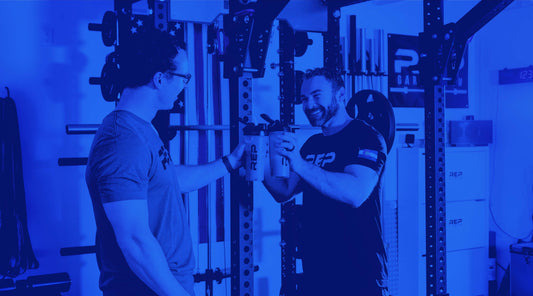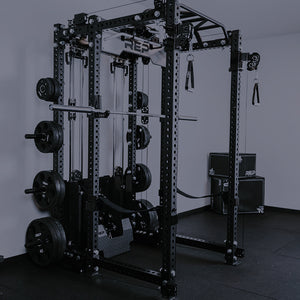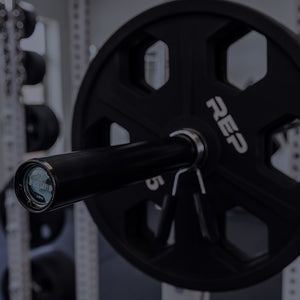
Better in the gym, better on the court.
Speed, agility, flexibility, strength, power, and endurance — tennis players need a well-rounded training routine for peak performance on the court. Dedicated time spent repping your slice, drop shot, and backhand are essential, but a weight room training routine can keep you injury free, moving quick and efficient, and outlasting your opponents.
We tapped strength and conditioning coach Dan Berman and former D.1 Ball State University tennis player Gena Tranquada (MAC Academic All-MAC honors, with 73 career win matches — the 9th highest in the school's history) to guide us through the best tennis exercises to support the sport.
The Importance of Strength Training Tennis Workouts
"The best tennis players are mentally tough and able to think on their feet... strategizing set after set," says Tranquada. Sure, tennis is a little bit like a game of Chess, where your next move often depends on anticpating your opponents. However, beyond the mental games, your bodies capabilities play just as big of a role. Transquada explains, "[These athletes] need to be able to move in any direction, have a strong core, and be flexibile in one moment and display explosive strength in another."
Adding a tennis strength training routine into the mix can help improve your endurance through long rallys and sets, increase explosive strength needed for serves and attacks, improve your speed and agility when chasing down lobs and cuts, and can strengthen your tendons and ligaments which can aid in keeping you injury free.
The 14 Best Exercises for Tennis Players
Check out these exercises to build strength, power, speed, and endurance to help you stay quick on your feet, explosive with your movements, injury free, and capable from first point to last. "Before diving in, remember to tackle a warmup and some dynamic stretches that prepare your body for the work to come," says Berman.
Med Ball Rotational Throw
Rotational strength is developed here, supporting the transfer of power driven by your hips and core. For power training, the National Academy of Sports Medicine recommends using a medicine ball that's around 10 percent of your body weight, allowing you to generate maximum force as quickly as possible.
How to:
- Stand about two steps away from a wall, hips perpendicular to the wall, with a medicine ball (in both hands) sitting on your outside hip.
- Soft bend in your knees and send your hips back slightly
- Pivot your outside foot as you throw the ball against the wall with as much speed as possible.
- Catch the ball and return it to your outside hip.
- Complete your reps then switch sides.
Depth Drop to Box Jump
The depth drop to box jump trains reactive strength, helping your muscles and tendons learn to absorb force when you land from the drop and then immidiately use that stored energy to jump. This type of explosive strength can help you change direction faster, recover quickly between shots, and generate power from the ground up.
How to:
- Setup with two boxes — the drop box should be about 12 inches high and the jump box should be a height you can land on with control.
- Start standing on the drop box then step off of the box.
- Land on the balls of your feet with a slight bend to your knees and hips.
- Limit your time on the ground by jumping as quickly as possible up and onto the second box.
- Land softly on the jump box and stand up tall.
- Step off the jump box and return to the drop box for your next rep.
Split Squat Jump
This basic plyometric exercise — a unilateral progression from a jump squat —helps to build explosive power and reactive strength, and the staggered stance also helps improve balance and stability. When power is the focus, as it is here, work on exploding as high into the air as possible, rather than short jumps for speed.
How to:
- Start in a split squat/lunge position with knees at 90 degree angles.
- Jump straight up as high as you can.
- Land softly in your starting position.
- Finish your reps on one side then switch legs and repeat.
Deadlift
The deadlift is a powerful compound exercise which targets your glutes, hamstrings, lower back, grip, core muscles, and more. Whether you're competing in strength sports or looking to build functional strength for picking things up off the floor, the deadlift is a power builder you won't want to miss.
How to:
- Stand with feet hip-width apart, toes slightly under the bar, and shins close to it.
- Hinge at the hips, bend your knees slightly, and grab the bar outside of your legs. Keep your back flat and hips below shoulders.
- Inhale, brace your core, and push through your legs to stand. Keep the barbell traveling as close to your shins as possible while engaging your lats and shoulder blades.
- Stand tall, then hinge at the hips and bend your knees to lower the bar back to the floor with control — maintaining a flat back and tight core.
Bulgarian Split Squat
This move has many names — Bulgarian split squat, rear-foot elevated split squat (RFESS), elevated split squat, single-leg split squat, and the "Oh God, I hate this" one. Whatever you call it, this lower-body strength exercise helps to train single-leg strength and balance, while primarily targeting your quadriceps, glutes, and core.
How to:
- Stand two feet away from a bench and rest the top of one foot on it behind you.
- Maintain a tall torso and tight core as you bend your front knee and lower the back knee down to the floor.
- Keep your front foot glued to the floor as you drive through your heel to return to standing.
Goblet Squat
The goblet squat supports strength, stability, and mobility — all key for tennis players — and, compared to heavy barbell back squats, tends to place less stress on the lower back because the load is held in front. This can help to train your legs without over-loading the spine.
How to:
- Stand tall and set your feet shoulder-width apart with toes slightly out. Hold a weight close to your chest with elbows tight to your body.
- Maintain a proud chest, keep you shoulder back, and brace your core.
- Lower down into a deep squat by sending your hips back and bending your knees.
- Drive through your heels to return to standing.
Dumbbell Front and Lateral Raises
For upper body strength and stability, dumbbell front and lateral raises target the anterior and lateral deltoids which are crucial for shoulder stability during powerful serves, precise swings, and controlled volleys. This strength also translates to better racquet control and speed, and helps prevent injury due to the strengthening of smaller stabilizers around the shoulder joint.
How to:
- Stand tall with core braced and a light weight dumbbell in each hand.
- For front raises, maintain a soft bend in your elbows as you lift the dumbbells straight in front of you to about shoulder height.
- For lateral raises, maintain a soft bend in your elbows as you lift up to the side, no higher than shoulder height.
- Keep your shoulders down throughout either movement and lower with control.
Bent Over Row
The bent over row targets your back — the rhomboids, traps, and rear delts. These muscles play a crucial role in maintaining posture, stabilizing your shoulder during powerful serves, and supporting the transfer of power from your legs and core to your arms when attacking the ball.
[Read More: Smith Machine Row]
How to:
- Place a knee and the same-side hand on a bench, with your free leg extended out to the side.
- Grip a dumbbell with your free hand and row it up, keeping your elbow grazying against your body as you send it up towards the ceiling.
- Lower the dumbbell back down, maintaining a neutral spine throughout.
- Finish your reps on one side before switching to the other.
Half-Kneeling Lat Pulldown
If you're looking to improve the power in your backhand and overhead shots, look no further than the half-kneeling lat pulldown. This move targets your latissimus dorsi muscle, which can help stabilize the shoulder joint — supporting powerful attacks and injury prevention. Tackling the lat pulldown unilaterally also supports anti-rotational strength, core stability, and a greater range of motion with a deeper pull.
How to:
- On a cable machine, set the pulley to a high position and attach a D-handle.
- Grab the D-handle with one hand and take a step back with the same side leg, dropping it down into a half-kneeling position.
- Engage your core and maintain a tall posture as you pull the D-handle down and slightly back, keeping your elbow close to your side.
- Slowly return the weight back towards the cable machine, maintaining tension on the lat throughout the movement.
Pallof Press
The Pallof press (named after physical therapist John Pallof) is an anti-rotation exercise in which your core and stabilizer muscles work to resist rotational forces. This helps build strong abdominals, protects your spine and shoulders during explosive movements on the court, improves the transfer of power by your legs and hips to your torso and arms, and supports a more stable, balanced torso during unstable positions — such as sudden changes in direction or reaching for a shot.
How to:
- Set the pulley on a cable machine around chest height and attach a D-handle.
- Grip the D-handle with both hands and pull the handle out to rest at your center.
- Engage your core and resist allowing your body to rotate in towards the cable machine as you extend your arms out and back.
- Finish your reps and switch sides.
Ab Wheel Rollout
"A budget-friendly ab wheel — that can fit in your bag and go with you to the gym or to practice — is one of the best value pieces of fitness equipment," says Berman. The ab wheel roll out trains anti-extension core strength, which can help protect your spine when hyperextending during serves and overhead attacks.
How to:
- Start in a kneeling position, on a pad or yoga mat for cushion for comfort.
- Grip the ab wheel with both hands, arms extended, and shoulders over the wheel.
- Engage your core and maintain a straight back.
- Roll the wheel forward as far as you can go without arching your spine.
- Use your core to pull the wheel back in as you come back to start.
Jump Rope
Grab a jump rope for some cardio and endurance training that can strengthen your heart, improve lung capacity, and increase your speed and agility.
How to:
- Maintain a soft bend in your knees as you swing the jump rope overhead, jump over it, swing the rope behind you, and repeat.
- Switch up the way you jump to add variety to your training stimulus — try double unders, side-to-side work, jump tucks, boxer skips, and single leg hops.
Forward/Backward Line Hops
The purpose of this drill is to move your feet as quickly as possible, helping to train your ability to quickly react, change direction, and maintain your balance. "The goal is to move your feet as quickly as possible back and forth over a line," says Berman. You can tackle this drill by finding a line you can jump over or with an imaginary line if you're in a pinch.
How to:
- Keep a soft bend in your knees and jump off of both feet, landing on the other side of a line.
- Quickly jump back to where you started.
- Repeat.
Pro Tip: Set a timer for 30 seconds and see how many line jumps you can complete in that time. Then, turn to the side and complete 30 seconds of side-to-side line hops over the line. Rest for a minute and then repeat.
5-10-5 Cone Drill
Cone drills can help you improve acceleration and deceleration, increasing your speed and ability to start, stop, and change directions. Before you begin, set up three cones in a straight line, each 5 yards apart.
- Start with your legs straddling the center cone.
- Sprint 5-yards and touch one of the far cones.
- Pivot, sprint 10-yards, crossing the center cone and touch the other far cone.
- Pivot, sprint 5-yards, back to the center cone.
- Rest and repeat, starting in the other direction.
Pro Tip: "If you don't have cones, use whatever you have available as 5-yard markers — hats, sandals, your gym bag — whatever you have available," says Berman.
Takeaway
Sometimes, all we want to do is hit the court and play — but adding a weight room routine can take your game to the next level. Power, plyometrics, and strength training builds speed, power, and resilience, which means more explosive swings, faster reactions, and a lower rick of injury.
Try incorporating a few (or all) of these tennis-focused exercises into your routine. Focus on perfect form first then gradually increase the load over time. Just wait — with dedicated time and effort, that newfound strength will directly affect your performance on the court.
FAQs
How to improve at tennis?
Tennis is a game of power, endurance, and finesse. If you're just starting out, you'll want to spend a good amount of time mastering the skills you'll need in games — serves, strokes, ball tracking, and footwork. You'll also want to add in strength, endurance, plyometrics, and speed and agility work to support your game.
What's the best tennis workout equipment from REP?
A cable system like the REP® ARES™ 2.0 can support strength, endurance, accessory lifts, and power training — allowing you to tackle lateral and front raises, rows, lat pull downs, cable chops, Pallof press, and so much more. We'd also recommend a barbell, adjustable dumbbells, a medicine ball, ab roller, competition speed rope, and soft plyo boxes to round out your home gym setup.
Rosie Borchert is a NASM-CPT, former Nike Volleyball coach, and fitness writer whose work has appeared on BarBend and Tonal. If anyone would like to hire her to play beach volleyball, snowboard, binge watch TV, or go climbing, please get in touch.
This article was reviewed by Ashley Boyer, ACE-CPT, for accuracy.
similar to this

NEWSLETTER SIGNUP
Product launch information, promotions, blogs, and REP news.







